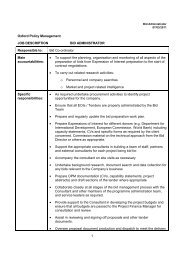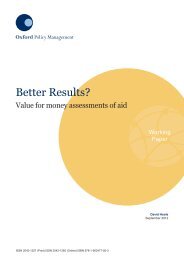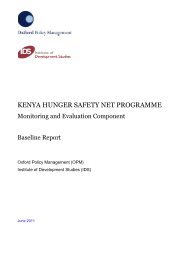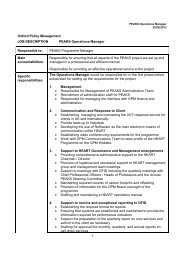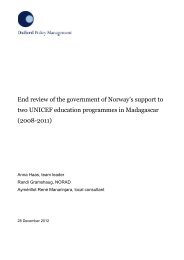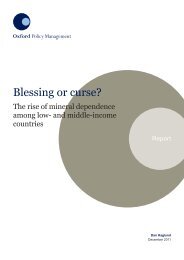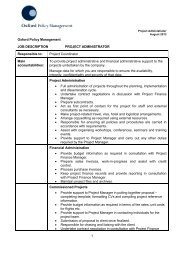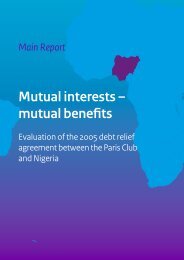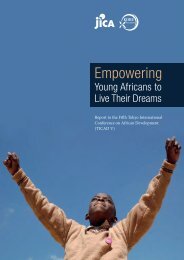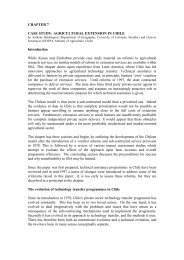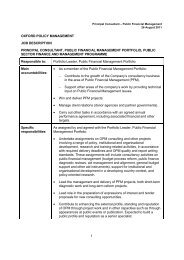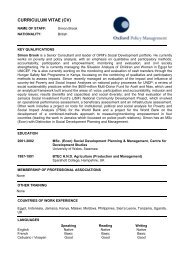LHW Systems Review - Oxford Policy Management
LHW Systems Review - Oxford Policy Management
LHW Systems Review - Oxford Policy Management
You also want an ePaper? Increase the reach of your titles
YUMPU automatically turns print PDFs into web optimized ePapers that Google loves.
Transportation9 Transportation‘We have a shortage of drivers because of the low salary package. We have 29 vehicles indistrict Muzaffarabad but 50 percent not being used due to shortage of drivers. Same asproblem in other districts which were affected by the earthquake as the NGOs are payingmore than Rs.10,000 a month.’ (RPIU manager, January 2008)‘Polio day comes then all the vehicles are involved in EPI. The vehicles are taken for 10days –for the polio days and post monitoring. So that is 90 days a year they take all thevehicles. They bring their own drivers from the health department or from open market. Or ifthey use our drivers then we give a payment. EPI pays the <strong>LHW</strong> and the LHS.’ (DistrictManager, January 2008)9.1 PurposeTo provide the transport for monitoring and supervision of the Programme – primarily of the<strong>LHW</strong>s in their communities, but also of their monthly meetings and training programmes.9.2 Performance measures• Percentage of functional vehicles in use by LHS; 69• No vehicle is over 10 years old; 70• LHS provided with an average of 70 litres per month POL (or Rs. 70 per field visit dayFixed Travel Allowance (FTA)); 71• Payment of the POL to the LHSs with vehicles, FPOs, and the Implementation Units(PC-1); 72 and• Travel allowance paid for LHSs without vehicles. 739.3 In operation9.3.1 DescriptionVehicles for supervision and monitoring The Programme purchases vehicles primarily forsupervision and inspection purposes. In most instances Suzuki Ravi pick-ups are provided.However for more difficult terrain, Suzuki Potohar Jeeps have been purchased. Managers,FPOs, and LHSs are required to make regular field visits for the purposes of monitoring andsupervision, and are provided with a POL. Vehicles purchased by the Programme are notpart of the general vehicle pool at the district level, and their use is restricted to Programmeactivities. Each district has a budget allocation for repair and maintenance, and POL.LHS mobility Each LHS is provided with a driver of her choice from her community 74 Whenthe LHS does not have a vehicle, or is without a driver, she is paid a travel allowance. POLfor the LHS should be, on average, 70 litres per month. 75 The actual amount of petrol69PC-1, <strong>LHW</strong>P: 54.70PC-1, <strong>LHW</strong>P: 46.71PC-1, <strong>LHW</strong>P: 37–8.72PC-1, <strong>LHW</strong>P: 37, 38, 45.73PC-1, <strong>LHW</strong>P: 37.74PC-1, <strong>LHW</strong>P: 39.75In the previous PC-1 (the Revised PC-1), the Programme budgeted a petrol allowance per LHS of Rs. 1,250 per month. TheFinancial and Economic Analysis of the 3rd Evaluation, March 2002, found that assuming an LHS would have to travel around1,000 km to meet all their <strong>LHW</strong>s twice a month, and assuming fuel consumption of 9 km/litre, this would require 111 litres per57



